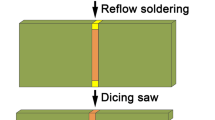Abstract
This study investigates the electromigration (EM) behaviors and effects of the addition elements on the formation of a Bi-rich layer in Sn58Bi-based solders including Sn58Bi (SB), Sn58Bi0.5Ag (SBA) and Sn58Bi0.5Ag0.1Cu0.07Ni0.01Ge (SBACNG) solders. The EM tests were conducted at a relatively high temperature of 373 K and at a current density of 30 kA/cm2. Although the dominant diffusing atom was Bi, hillocks were formed from Sn more easily than from Bi. The electrical resistance increased in the solder during the current stressing, and the dominant factor was attributed to the formation of a Bi-rich layer. SBACNG solder showed the highest resistance to the formation of a Bi-rich layer, followed by SBA, and then SB solder. The possible addition elements enhancing the resistance of SBACNG solder are Ag, Ni and Ge. The effects of the addition elements are summarized as follows: (1) Ag distributes in the Sn phase as Ag3Sn intermetallic compounds (IMCs) that enhance the mechanical strength of Sn; (2) Ni distribution in Bi as Ni-Bi IMCs stabilizes Bi and suppresses its migration; and (3) Ge may distribute in Bi, stabilizing Bi, or Ge exists at the phase boundaries as a precipitate that inhibits Bi migration.
Similar content being viewed by others
References
Z. Mei and J.W. Morris Jr., J. Electron. Mater. 21, 599 (1992).
J. Glazer, J. Electron. Mater. 23, 693 (1994).
Q.L. Yand and J.K. Shang, J. Electron. Mater. 34, 1363 (2005).
L. Chen and C. Chen, J. Mater. Res. 21, 962 (2006).
C. Chen, L. Chen, and Y. Lin, J. Electron. Mater. 36, 168 (2007).
J.R. Black, Proc. IEEE 57, 1587 (1969).
M.J. Attardo, J. Appl. Phys. 41, 2381 (1970).
H. Abé, K. Sasagawa, and M. Saka, Int. J. Fract. 138, 219 (2006).
H. Gan, W.J. Choi, G. Xu, and K.N. Tu, JOM 54, 34 (2002).
C.C. Yeh, W.J. Choi, K.N. Tu, P. Elenius, and H. Balkan, Appl. Phys. Lett. 80, 580 (2002).
Y.H. Lin, Y.C. Hu, C.M. Tsai, C.R. Kao, and K.N. Tu, Acta Mater. 53, 2029 (2005).
C. Chen and S. Chen, J. Appl. Phys. 90, 1208 (2001).
H. Gan and K.N. Tu, J. Appl. Phys. 97, 063514 (2005).
X. Zhao, M. Saka, M. Yamashita, and H. Hokazono, J. Solid Mech. Mater. Eng. 7, 118 (2013).
C. Chen, C. Huang, C. Liao, and K. Liou, J. Electron. Mater. 36, 760 (2007).
C. Chen and C. Huang, J. Alloys Compd. 461, 235 (2008).
H. He, G. Xu, and F. Guo, J. Mater. Sci. 44, 2089 (2009).
X. Zhao, M. Saka, M. Yamashita, and H. Hokazono, Microsyst. Technol. 18, 2077 (2012).
R. Rosenberg and L. Berenbaum, Appl. Phys. Lett. 12, 201 (1968).
T. Kawanoue, H. Kaneko, M. Hasunuma, and M. Miyauchi, J. Appl. Phys. 74, 4423 (1993).
M.S. Lee, C.M. Liu, and C.R. Kao, J. Electron. Mater. 28, 57 (1999).
V.I. Dybkov and O.V. Duchenko, J. Alloys Compd. 234, 295 (1996).
C.M. Chen and S.W. Chen, J. Electron. Mater. 29, 1222 (2000).
Author information
Authors and Affiliations
Corresponding author
Rights and permissions
About this article
Cite this article
Zhao, X., Saka, M., Muraoka, M. et al. Electromigration Behaviors and Effects of Addition Elements on the Formation of a Bi-rich Layer in Sn58Bi-Based Solders. J. Electron. Mater. 43, 4179–4185 (2014). https://doi.org/10.1007/s11664-014-3400-2
Received:
Accepted:
Published:
Issue Date:
DOI: https://doi.org/10.1007/s11664-014-3400-2




